-
Posts
2,461 -
Joined
-
Last visited
Content Type
Profiles
Forums
Gallery
Events
Posts posted by Dr PR
-
-
I use a small paintbrush to loosen the dust. I hold the end of a vacuum cleaner hose close to the model to suck up the loosened dust.
CAUTION: Remove any loose parts (not fastened down) first or you may have to sort through all the dust and lint in the vacuum bag. Guess how I know?
- Knocklouder, CPDDET and davyboy
-
 1
1
-
 2
2
-
Most people seem to use a plank bending method with the planks off the hull and in some type of jig. Some boil or steam the planks, and some people just soak them. In my opinion this is all way too much trouble and the results are less than perfect.
For me the best way is to shape the plank on the hull, where the hull serves as the jig and has the exact curvature and twist necessary. Here are a couple of links that illustrate this method.
You don't say what type of "plank bender" tool you are trying to use. That could influence the method you try.
-
When I first saw your pictures I imagined an auger screw stoker mechanism as used on some steam locomotives. But then I realized it was a conveyer bucket system. These were in common use so it makes sense.
But it would be interesting to see how it actually worked. It was probably steam powered. When steam pressure was high the stoker would run slower, and when the pressure was low it would have to "shovel" faster. I hope you find more information about how it worked. I wonder if it was patented?
- Canute, Glen McGuire and Keith Black
-
 3
3
-
Sagrado,
Since the HMS Beagle was a British Royal Navy ship you should look for information about how the Royal Navy was rigging the lifting tackle in the first half of the 1800s.
I would bet on the rig shown in your first images from "The Age of Sail."
However, keep in mind that there were probably as many ways to rig these tackles are there were ships, Captains and Bosuns. If you cannot discover exactly how it was done on the Beagle (and did the method change over time?) you are free to do whatever you want so long as it is reasonable.
-
I have been planking the main deck.
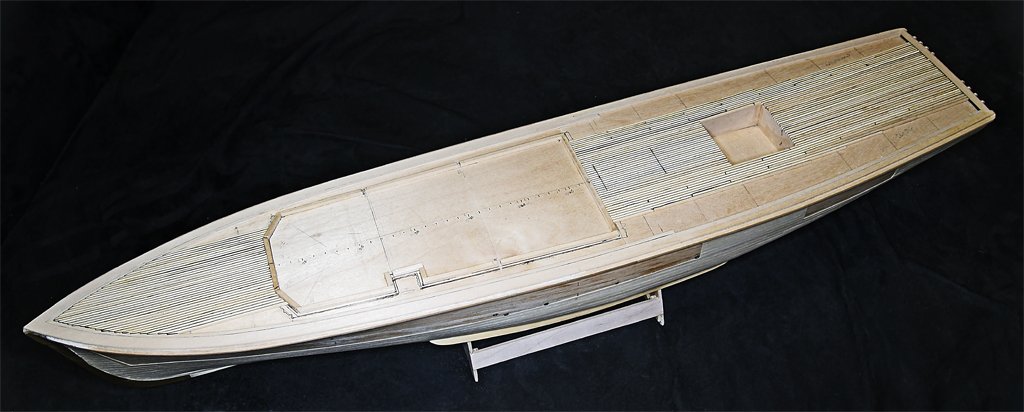
As you look at these photos keep in mind that this is the rough deck. It has not been sanded or sealed.
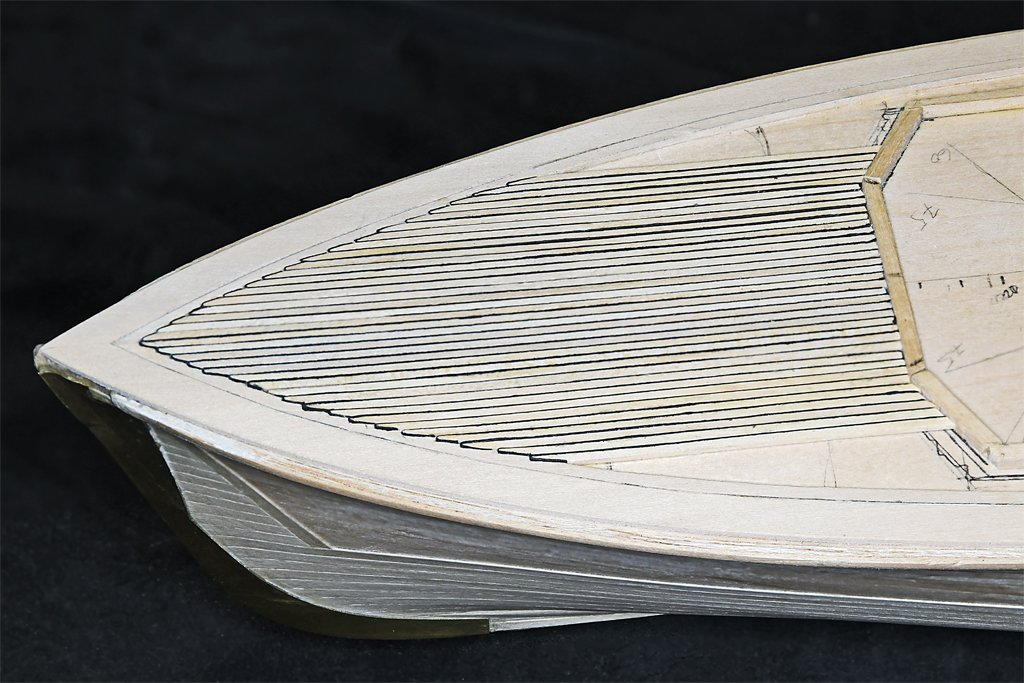
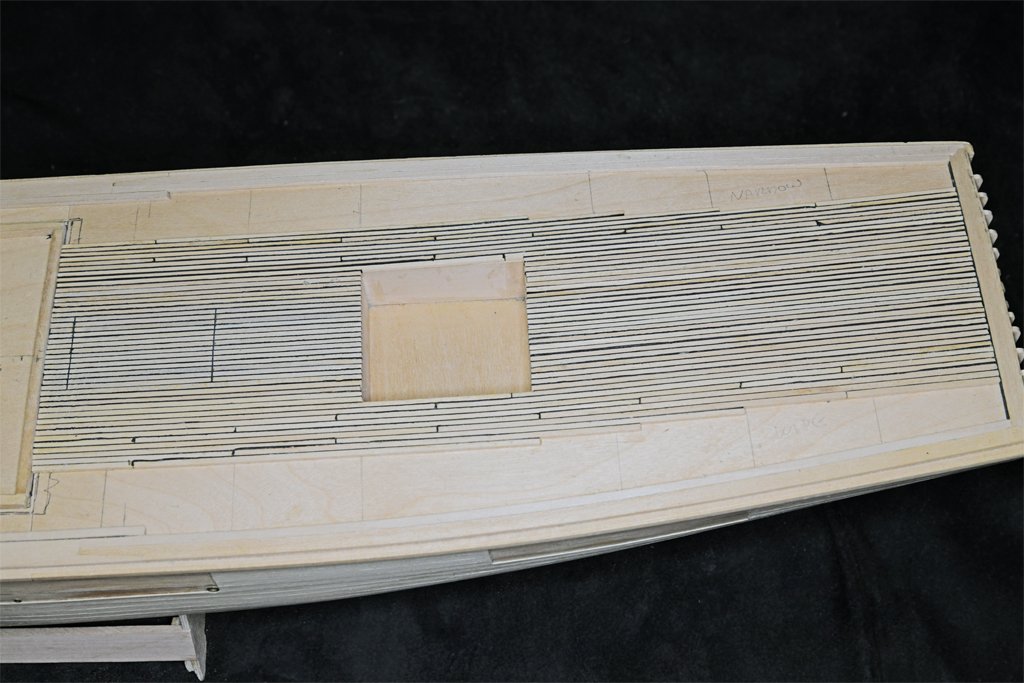
The blueprints say plank ends will be spaced at least four frame spaces with three passing strakes between butts in line. The planks should be laid parallel to the centerline "... in as long lengths as practicable ..." How long was "practicable" when they were building this ship?
The planking strips are 24 inches (610 mm) long. I decided to use 5 inch (127 mm) long planks (20 scale feet or 6 scale meters) because that is 16 frame spacings. This way I can use multiples of 4 frame spaces (1.25 inch or 31.75 mm), or planks 1/4, 1/2, 3/4 and 1 plank length long to stagger the plank ends lengthwise. Some of the planks are actually longer that 16 frame spaces at the bow and stern.
 The blueprints specify deck planks 2 5/8 inch (66.7 mm) square, or 0.055 inch (1.4 mm) at 1:48 scale. The closest commercially available strips were nominally 1/16 x 1/16 inch (0.0625 x 0.0625 inch or 1.6 x 1.6 mm). However they range from 0.055 to 0.075 inch (1.4 to 1.9 mm) and none are actually square in cross section.
The blueprints specify deck planks 2 5/8 inch (66.7 mm) square, or 0.055 inch (1.4 mm) at 1:48 scale. The closest commercially available strips were nominally 1/16 x 1/16 inch (0.0625 x 0.0625 inch or 1.6 x 1.6 mm). However they range from 0.055 to 0.075 inch (1.4 to 1.9 mm) and none are actually square in cross section.
I cut the strips to the desired plank length and then glue a strip of black paper to one side. I usually place the narrowest dimension of the plank vertically so it will take fewer strips to plank the deck.
The paper is about 0.005 inch (0.127 mm) thick, and this is 0.24 inch (6.1 mm) at 1:48 scale. The blueprints call for a 0.25 inch (6.4 mm) grout so the paper and glue are just about the perfect thickness.
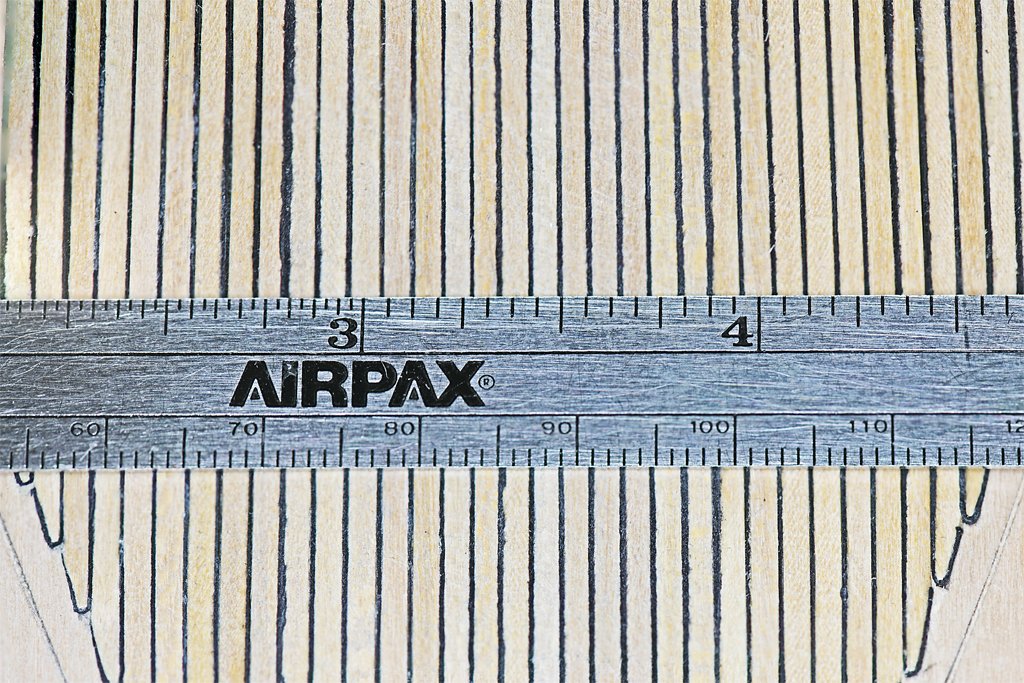
The paper strips were cut on an ordinary paper cutter, eyeballing the widths, so they are not uniform. They protrude a bit above the tops of the planks. With handling the tops of the paper strips "fuzz out" and appear wider than the nominal width, making the grout look non-uniform. But after all the planking is done the deck will be scraped, sanded and finished with #0000 steel wool and the grout lines will be much more uniform in width.
Nibbing the planks into the nibbing strake along the edge of the deck is much harder that it was on the topsail schooner build - it had 5 mm wide planks. As you can see in this macro photo the nibbing isn't "perfect." It has taken a bit of practice to get it more uniform in appearance, and I screwed up in a few places.
Fortunately part of the fore deck is covered by a steel chafing plate where the anchor chain runs, and this will cover the worst of the screw-ups! Phil 1, Murphy 0!
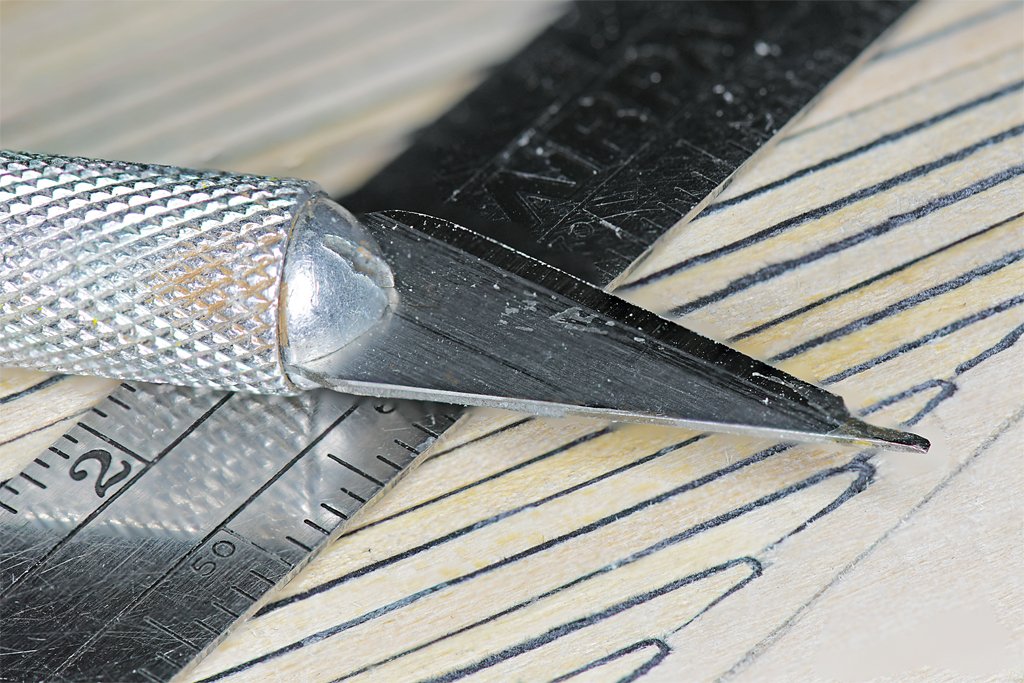 I soon learned that I could not cut uniform nibs with just a #11 hobby knife blade. The solution was to use an old, dull #11 blade with a broken tip, and shape the tip to make a "nibbing tool."
I soon learned that I could not cut uniform nibs with just a #11 hobby knife blade. The solution was to use an old, dull #11 blade with a broken tip, and shape the tip to make a "nibbing tool."
I used a grinding wheel in my motor tool and cut the tip to about 0.030 inch (0.76 mm) wide, with a chisel tip on the end. This is about half a plank width, and that is how wide the nib tip should be. I ground a cutting edge on the end, and then sharpened it on a whet stone.
I first use this tool to make the initial cut at the edge of the nibbing strake. Then I cut back from there to where the plank edge meets the edge of the nibbing strip. The plank is then shaped to fit the nib cutout. I usually have to trim the plank a bit narrower at the nib to account for the thickness of the paper grout.
No two nibs have the same angle cut, and the nibs get longer as the planking progresses toward midships. Some of the planks will have very long tapers, especially along the deck house sides. It is pretty tricky trying to cut long straight tapers into the nibbing strake.
-
Valeriy,
I am aware that the calculations for creating truncated cones are on line - I even have them in an ancient printed analytic geometry text book. But the Internet takes the fun of doing the trigonometry out of it, doesn't it?
But where your experience comes into the story is that you know how to do it, and know what to look for to do the calculations. And of course you do excellent work with brass and soldering! That is part of your talent.
- FriedClams, Keith Black, Canute and 4 others
-
 6
6
-
 1
1
-
Valeriy is too modest - he is obviously one of the most talented ship modelers on the planet! All of the great tools will not build a model, not even in the hands of an untalented modeler.
The geometry of the "ventilator visors" is not trivial. It looks like he made them from four pieces - two curved ends and two straight sides. Those curved ends are halves of a conic section, and anyone who has tried to figure out the correct "flat" layout for a conic section knows it isn't trivial. Try cutting a truncated cone with specific angles from a piece of paper and you will see it isn't easy!

I designed this single piece "visor" in 3D CAD and that takes a lot of patience. In this case the smoke pipe had different radii fore and aft.
I had to flatten the 3D model into a 2D plane, one facet at a time (the program didn't have a "flatten" function). That was very tedious!
Then I photo etched the part (sorry for the blurry picture).
It was a lengthy and non-trivial process that took several days.
Valeriy is very good at this sort of thing and makes it look all too easy!
- Keith Black, GrandpaPhil, cotrecerf and 6 others
-
 8
8
-
 1
1
-
It was common on many vessels (especially smaller non-military ships with small crews) to forego the becket and just tie the standing part around the block strop.
In some cases the standing part of the tackle was tied in a knot around the block strop, as illustrated in Monfeld's Historic Ship Models on page 245.
Some people just loop the standing end under the block strop then pull the end back and seize an eye around the strop. This is perhaps the best way to attach the standing end on small scale models.
Sometimes a separate length of line was pulled under the strop, looped around a thimble and seized to create a becket.
And on some ships a separate becket was seized into the block strop. I suspect this method was more common on naval ships with large crews with little to do when not engaged in battles.
Unless you know the exact way blocks were stropped on the original vessel you are modelling you are free to use whatever method appeals to you.
- Keith Black, robert952 and palmerit
-
 3
3
-
Gary,
Not as nice as it might have been! A lot of things were screwed up pretty badly when the glue set. The angles of the front three panels were way off. I tried to repair the problems, but the "repaired" piece still had a lot of problems.
If at first you don't succeed, try, try again.
The problem seems to have been caused by the side pieces moving back and forth while I was assembling all of the panels and supports for the front of the superstructure. The thing just wasn't rigid enough to hold its shape.
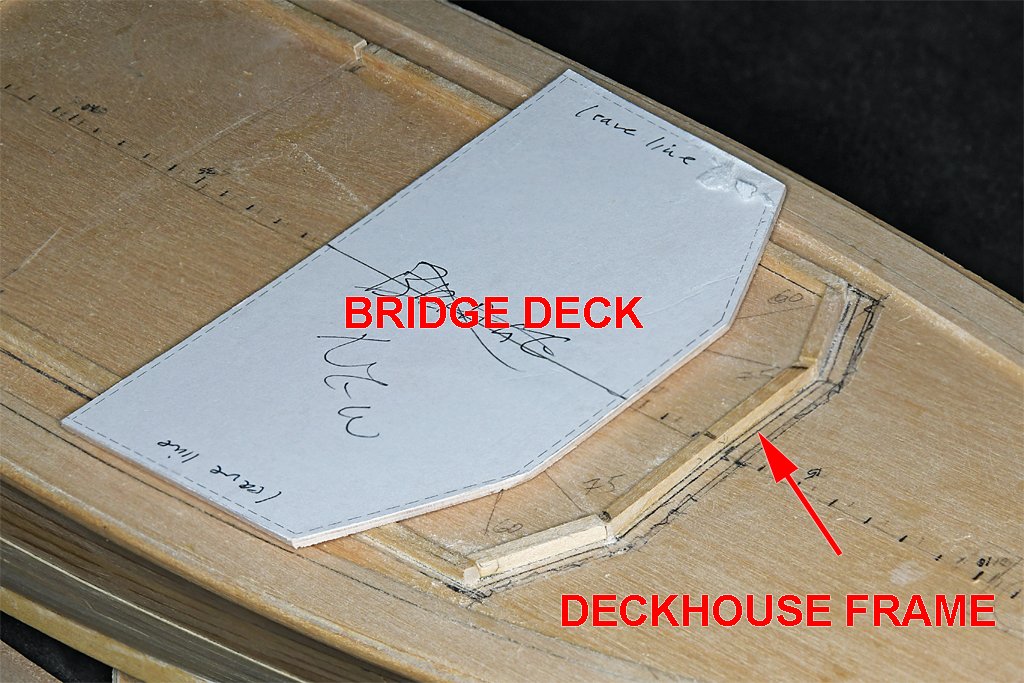
The blueprints show the front panels resting at an 85 degree angle to the deck, and they join each other at 150 degree angles. At the sides they join the deck house sides at approximately a 120 degree angle, but not quite because the house sides are not parallel.
I double checked the deckhouse frame that is glued to the sub deck against a printed template, and all of the angles were correct. Likewise the bridge deck - that rests on the deckhouse sides - also had the correct angles.
But the front panels did not align properly at the top edges with the bridge deck - they were way off in places! There wasn't any way to correct the errors, so the three front panels were chopped out and I started over.
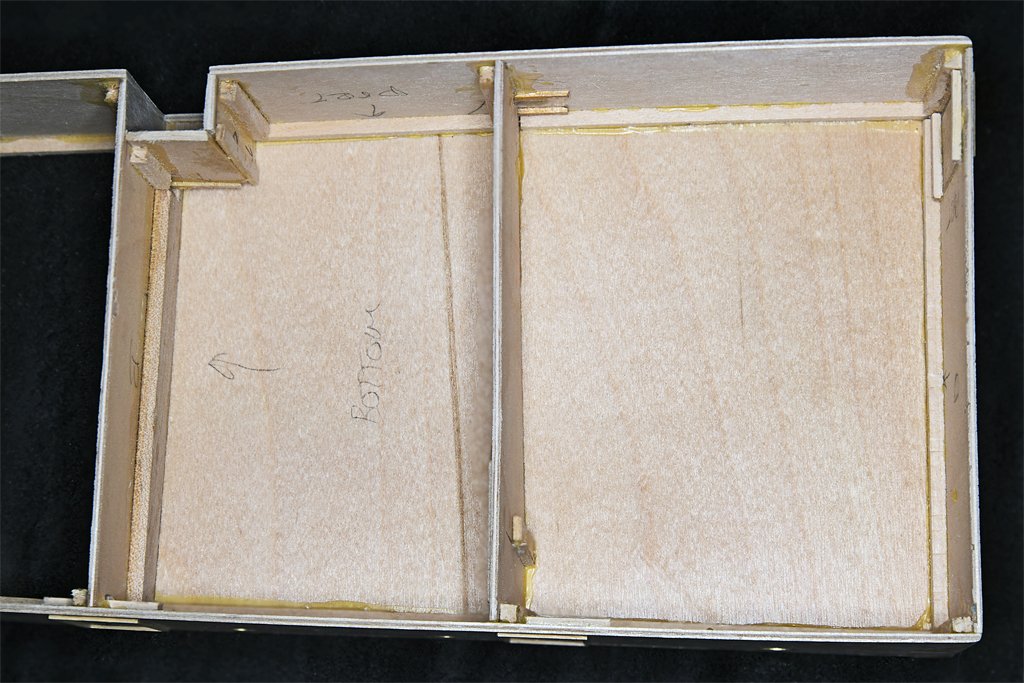 The first thing to do was realign the sides and rear bulkhead to the deckhouse frame and glue it all together.
The first thing to do was realign the sides and rear bulkhead to the deckhouse frame and glue it all together.
Then the top rear O1 level deck was glued on. Once this was in place the structure was rigid. This piece is 1/16 inch (1.6 mm) plywood and was pretty stiff. The deck has camber, but no sheer. The interior bulkheads were all cut with the camber, so I needed to bend the plywood to the correct curvature.
I wet the plywood and then bent it over a couple of wooden sticks. The edges were clamped to a very stiff 1/4 inch (6.35 mm) thick piece of aluminum plate. Then the plywood was pre-heated with a hair dryer and the whole thing was placed out into the noon day sun. After a few hours at 80+ Fahrenheit (28 Celsius) the plywood was dry and had adopted a nice camber.
While the glue was setting I added the walls for the small nook in the port side of the deckhouse. There is a scuttle in the main deck here that was the escape route for the forward minesweeping generator engine room.
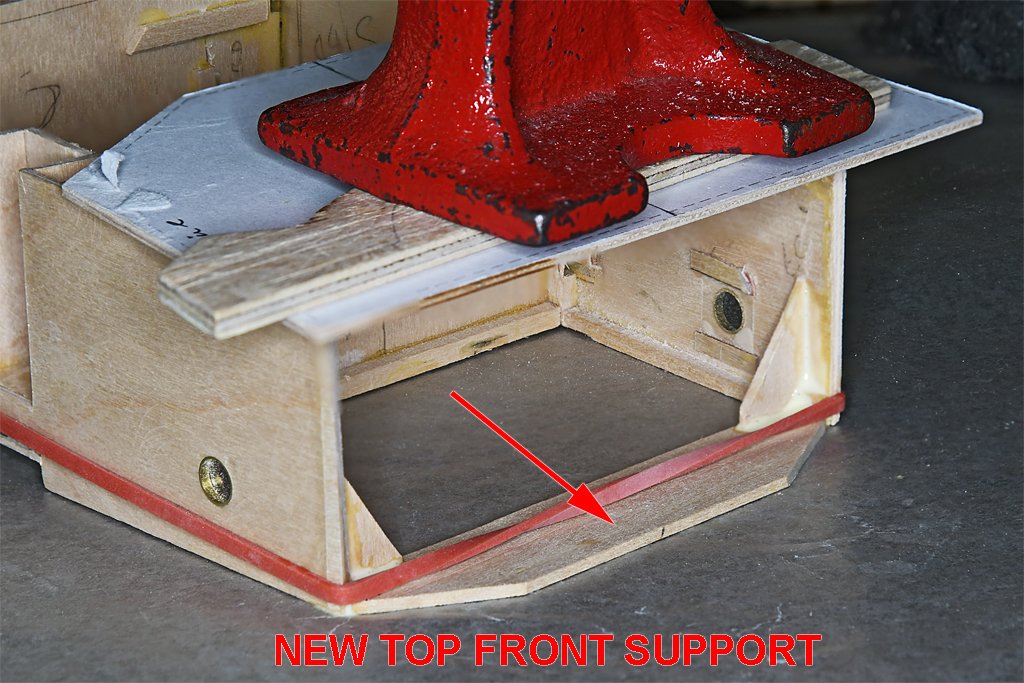 With the rigid deckhouse structure to work with I devised a simple solution for aligning the front panels. I cut a piece of 1/16 inch (1.6 mm) basswood to match the shape of the front of the deckhouse frame and bridge deck.
With the rigid deckhouse structure to work with I devised a simple solution for aligning the front panels. I cut a piece of 1/16 inch (1.6 mm) basswood to match the shape of the front of the deckhouse frame and bridge deck.
After the leading edges of the sides were prepared at the proper angles to mate with the front pieces, the new top front support was glued into place, with a couple of additional supports to strengthen the assembly.
In this photo the deckhouse is upside down and resting on a sheet of waxed paper. I applied an excess of Titebond Original glue to be sure everything was glued together. The waxed paper prevented the deck house from being glued to the work bench. I have had enough problems with this already and don't need for that to happen!
Next I shaped the two side panels to fit the house sides, deckhouse frame and top front support piece. These pieces were cut oversized on all sides and then cut, filed and sanded to fit. Then they were glued into place, and additional support pieces were glued into the angles between the front pieces and the house sides. I wanted these parts to be well supported.
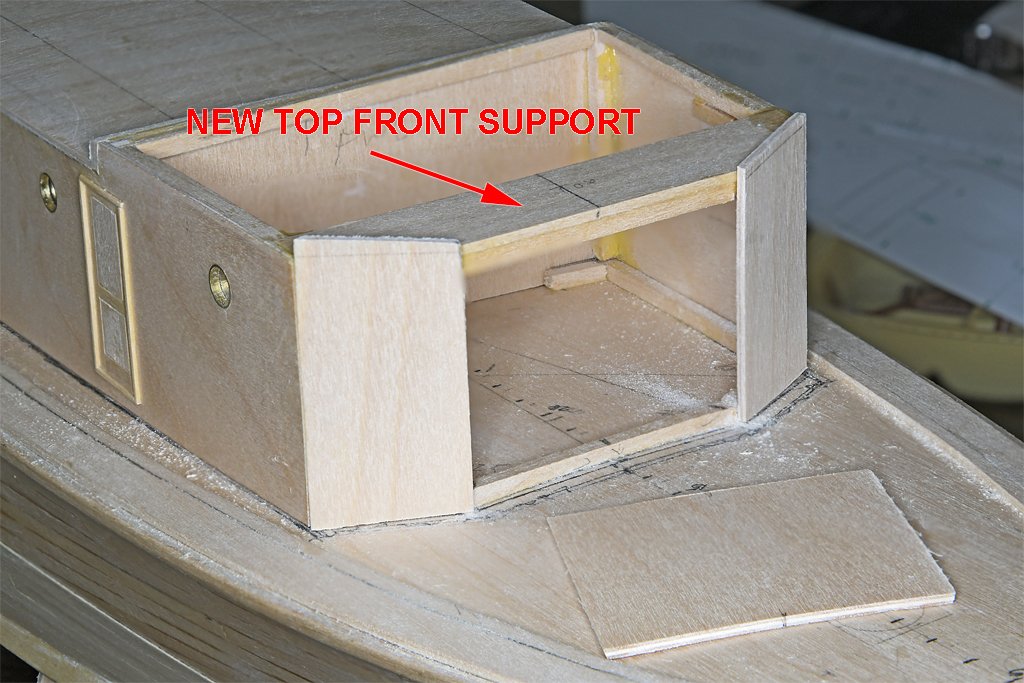
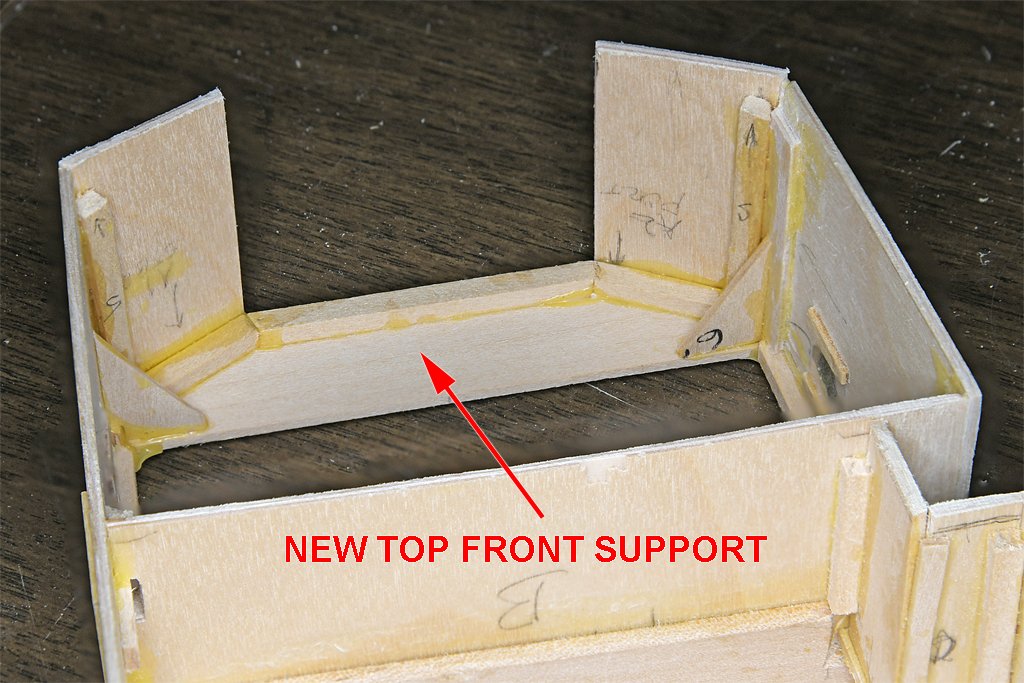
Note that the deckhouse parts are not glued to the deckhouse frame on the main deck. I want to remove the deckhouse while planking the deck, and to continue construction of the O1 level deckhouse and bridge away from the hull.
After the side panel glue had hardened over night I shaped the front panel piece to a tight slip fit between the side panels. Then it was glued into place.
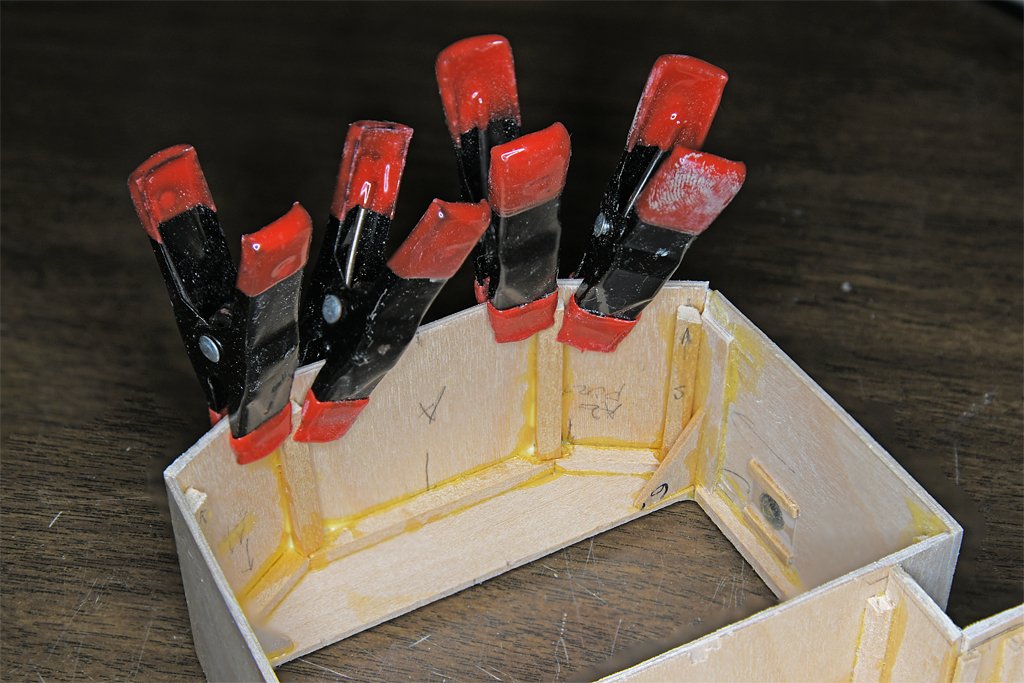

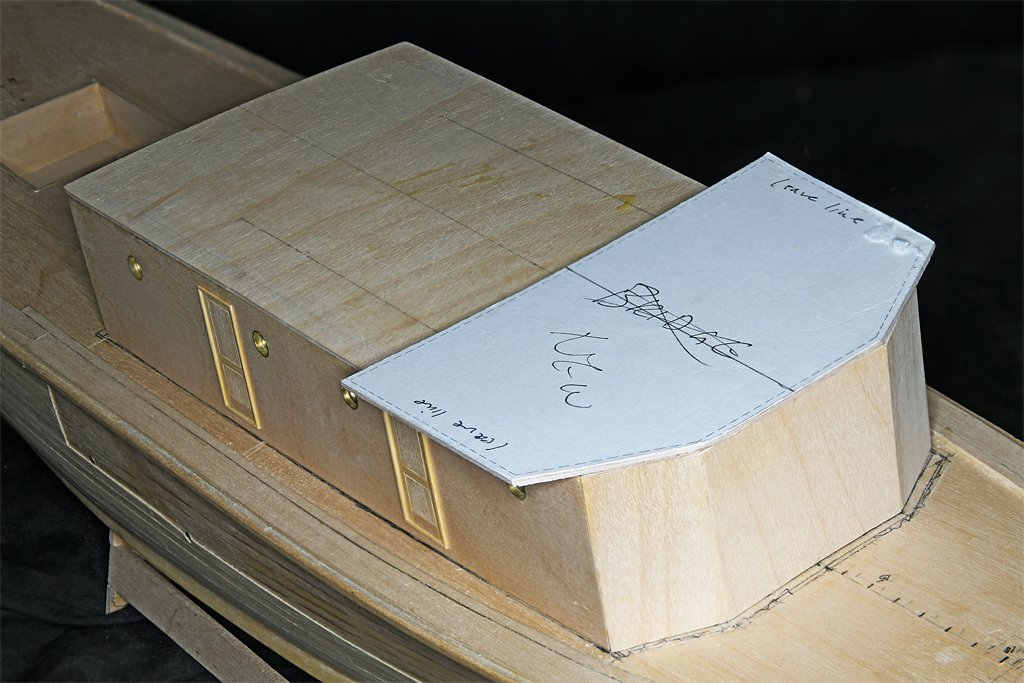
They say the proof of the pudding is in the tasting - or in this case how well the bridge deck fits to the deckhouse structure.
It is as close to a perfect fit as I can get! All of the angles align the way Phil and BuShips intended. I should have assembled it this way in the first place (hindsight is always clearest)!
Now I can start the main deck planking, and while the glue is setting I can do some work on the O1 superstructure (radio room and pilot house) and bridge.
Here are a couple more photos of the main deck deckhouse.


And the deckhouse in place on the hull.

-
Shellac will hold the seizing, but it doesn't adhere to polyester rope. It hardens and appears t hold the rope - as do other glues. But if you put a strain on the rope the polyester will just slip through the glue like it was greased!
- Keith Black, palmerit and robert952
-
 3
3
-
I would add a word of warning about stropping blocks (and other things) with seizing.
I used polyester rope with very fine silk thread for seizing. After wrapping the seizing tight I soaked it with white glue. After the glue dried the seizing was very solid. But the glue did not stick to the polyester rope, and it easily pulled out of the seizing if any strain was placed on the assembly. This left a nice tight hollow tube of seizing around one end of the rope, and a failed rigging. This happened to seizing that had been made weeks earlier when I started adding the rigging to the model. This caused a lot of difficult repairs!
I tried several different glues to fasten the ends of the polyester rope together. All failed except CA (cyanoacrylate or super glue).
After wrapping the rope around the block (hook, eye, etc.) I place a small amount of CA on the two strands of rope. Then I wrap the seizing around it.
If I try to tie the seizing over the wet CA I cannot wrap the seizing fast enough before the glue hardens. The result is a lumpy seizing. I spread the CA evenly and let it harden before starting the seizing.
- robert952, Keith Black and Kenchington
-
 3
3
-
I recommend you glue the hatch gratings in place after all the work around them is complete.
I left the hatch gratings loose on a model I built back in the 1960s, with just gravity and a tight fit holding them in place. Decades later, having forgotten the gratings were loose, I was dusting the model with a soft brush and a vacuum cleaner off to the side when suddenly the hatch grating popped up and went into the vacuum cleaner.
Digging through the dust, hairs and miscellaneous bits of this and that is not something you really want to do!
The gratings have since been glued in place.
-
Very nice! The model is starting to look like the real thing.
- Keith Black, Glen McGuire, FriedClams and 1 other
-
 3
3
-
 1
1
-
Pear wood stained with Varathane "Gunstock" color wood stain produces a nice reddish "mahogany" color.
-
A bit more progress on the doors and deckhouse.

These are the pilot house doors. The door on the left is partially assembled. It is 1/32 (0.0325) inch (0.8 mm) thick pear wood strips and panels glued onto a 1/32 inch thick plywood backing. This is the rough door before sanding and staining.
I knew I couldn't create uniform width grooves for the white trim, so I took a hint from small craft builders who needed white grout between planks. I used some 0.020 inch (0.5 mm) white styrene strips.
The window is a 0.005 inch (0.13 mm) thick piece of acrylic sandwiched between two thin (>0.015 inch/0.38 mm) rings cut from a 0.28 inch (7.1 mm) diameter brass tube. The inside diameter is 0.25 inch (6.4 mm) or 12 inches at 1:48 scale.
The door on the right is finished with Varathane wood stain, in the "Gunstock" color. The pear stains nicely and I like the resulting reddish "varnished mahogany" color.
I have been wondering how to get a good mahogany color and this stain works well. All of the door and window trim around the pilot house was mahogany. While rummaging through my wood stash I found a bag of 3.75 x 0.093 x 0.045 inch (95 x 2.4 x 1.1 mm) HO scale railroad ties that appear to be real mahogany! I remember buying these in the 1970s to be used as hull planks for a scratch built ship's boat. These "ties" are a good size for the door and window trim, and the window frames.
I was working on the doors while the glue set on the deck house assembly.

This assembly is tricky because there are no right angles. The deck house is narrower at the front than at the rear, so the sides aren't parallel. The deck has significant sheer forward but the bulkheads should be vertical perpendicular to the water line. The attachment of the forward angled bulkheads to the side pieces is critical for getting all the other pieces right.


I added a lot of interior bracing to make it strong enough to hold up to handling The first attempt to put it together came out too wide, and it didn't fit the house outline framing glued to the subdeck. I had to disassemble the port side and reshape the pieces to fit correctly. I am using Titebond Original wood glue and it can be softened with water and heat. So I soaked the joints and heated them with a hair dryer. It came apart "reluctantly!"
The interior bulkheads are just clamped in place at this point. They set the angles where the front and side pieces join.
-
Here is a bit more progress on things that must be done before the deck house parts are assembled. I have cut out the door and air port openings on the deck house sides. Then I stripped off the paper templates, sanded the wood smooth and applied a coating of acrylic sealer. And I made all the weathertight doors except the mahogany doors for the pilot house.


This is the prototype door positioned in the after deckhouse bulkhead - with the panels removed and installed correctly! I am using Titebond Original wood glue, and it can be loosened with heat. I used my plank bending/sail making/quilting iron tool as a debonding heater to loosen the glue.
The door frames are 1/32 x 3/32 inch (0.8 x 2.4 mm) boxwood strips glued into the opening in the 1/16 inch (1.6 mm) thick plywood bulkhead. Technically the bottom sill should be 0.0026 inches (0.066 mm) thicker than the side and top sills, but with my tools I have no way to produce this.
The grooves in the door stand out nicely! The finished door will have a brass door knob made from a small brass nail.
I made the air ports with a 1/16 inch (1.6 mm) long piece of 0.28 inch (7.1 mm) outside diameter brass tubing. The inside diameter is 0.25 inch (6.4 mm), or 12 inches (305 mm) at 1:48 scale. These were sawn off the end of the tube a bit longer than needed. Then they were pushed into a hole in a piece of 1/16 inch thick plywood and filed down until they were as long as the thickness of the plywood. It would have been easier and quicker with a lathe!


\
I glued squares of 0.005 inch (0.127 mm) thick clear styrene on the inside of the bulkhead, with additional scrap wood pieces to hold them in place. I have considered adding an additional 3D printed piece on the inside of the air port that is shaped like the metal inside cover and painted the typical US Navy interior puke green. Whether I actually do that remains to be seen. But if I do they really won't be seen at this scale, so why bother?
- Paul Le Wol, Canute, Nirvana and 6 others
-
 9
9
-
Thanks to everyone for the comments and likes!
I have a bit more progress to report. The forward bulkhead of the deck house is the key to the entire assembly. The three pieces join at 150 degree angles so they must be beveled 75 degrees on the sides where they join. In addition, they have to conform to the camber of the deck, they are vertical relative to the water line, and the deck has a significant sheer. There are no "square" corners or 90 degree angles, so there is plenty of opportunity to screw up!
 I worried about this a lot, trying to figure out the shape of the two side pieces. I modeled it in 2D CAD, based on the deck camber. But the first two side pieces didn't come close to fitting! Then I did it in 3D CAD, taking into account the angles of the parts, and came up with what you see here.
I worried about this a lot, trying to figure out the shape of the two side pieces. I modeled it in 2D CAD, based on the deck camber. But the first two side pieces didn't come close to fitting! Then I did it in 3D CAD, taking into account the angles of the parts, and came up with what you see here.
These pieces have to be assembled first. Then the rest of the deckhouse will be added to them - again at some odd angles. The house sides join the outer two front pieces at 120 degree angles, so the parts must be beveled 60 degrees on the joining edges.
I used interior support pieces angled at 150 degrees to glue the pieces together. Then additional 1/8 x 1/8 inch (3.2 x 3.2 mm) pieces were glued to the inside of the joints for additional strength.


I guess I did get it right because the pieces seem to come together correctly. At this point the outer front pieces are oversized and will have to be trimmed back and beveled appropriately. Only the front three pieces are glued together. Everything else is just clamped in place. There is a lot more work to do on the house sides before they can be glued to the front and interior bulkheads.


There are seven "weathertight" doors (not watertight) on the exterior of the superstructure, Three at the main deck level and four on the O1 level. The doors were made like the doors in houses in the 1950s. They had two center panels that had "V" shaped grooves all around. I want to try to replicate this.
Here is a "door kit."


The side and top parts are 3/32 x 1/32 inch (2.4 x 0.8 mm) boxwood, the bottom piece is 5/32 x 1/32 (4 x 0.8 mm) boxwood, and the center panels are 1/32 inch plywood. The 1/32 inch plywood panel at the right is the finished door size. The other parts are glued to it to create a 1/16 inch (1.6 mm) thick door, as shown on the right. The block at the left is the template for cutting the door openings. The doors are a bit smaller, and will have 1/32 inch frames all around.
There is a problem here. In my rush to assemble the door I put the wider 5/32 inch bottom part at the top! Well, it is a prototype, and Murphy had a hand assembling it. Reminds me of the topsail schooner build where I go in a hurry and switched the pintles and gudgeons for the rudder! How embarrassing!

The doors were all painted gray on the outside. But inside they were varnished mahogany. The two doors to the pilot house will be open, as shown in this rather grainy photo. The grooves around the center panels were painted white.
I want to replicate this in the model. The windows and window frames were also mahogany, as were the frames for the windshield, railings around the bridge and on the bulwarks, and a lot of the interior of the pilot house.
I will be experimenting with pear wood to try to get the nice red mahogany color. But if that fails I will just paint the doors with "mahogany" paint.

Here are pieces of the boxwood and plywood used in the prototype that have been stained with Minwax premium oil penetrating stain. This is "Red Mahogany 225."
Looks more like brown mud! I have tried to use this stuff before and this is the best results I have had. Blotchy and streaked. Awful!
This is why I said I may just paint the wood.
-
-
-
I have basswood, boxwood and cherry. I have had horrible results trying to stain basswood, so that is out.
It would be nice if I could stain boxwood. It carves nicely, and the doors have some detailing grooves like something you would see on indoor doors in a nice house.
I might also order cherry if I don't have enough for the two or three doors I want to be open.
On the inside of the doors the mahogany was varnished and the grooves were painted white. It would be a nice detail on the open doors.
Because of these grooves, and the fact that I don't have a milling machine, I may build up each door from seven pieces with beveled edges where appropriate. The doors are small (1.3" x 058", or 33 mm x 1.47 mm), but large enough that I should be able to make them.
-
-
I have made a little progress on the physical model. Most of my time has been spent on planning the build sequence. The deck planking will go down first before the deck house and deck furniture is placed. But I wanted to get the main deck deckhouse pieces glued together before proceeding with the deck planks. That way I can be working on the superstructure off the hull while I am waiting for the planking glue to set.
The front pieces of the superstructure fit together at angles so I had to bevel the edges. The sides also come together with the front pieces at an angle. Setting up the disk sander to the proper angles took some trial and experiment. I also need to cut openings for doors and air ports in the pieces before they are assembled.


I made a wooden block "template" for cutting the door openings. This will ensure that all the door openings are the same size. I am also gluing some of the 1/8 inch (3.1 mm) square framing strips in the corners where pieces come together..



After the holes are cut and the pieces are trimmed to fit I remove the paper pattern and scrape/sand any remaining glue to prepare the surfaces for painting.
I am planning to make the 12" air ports with some brass tubing with 1/4 inch (6.35 mm) inside diameter. I want to make the window with 1/4 inch acrylic rod. The outer surface will be polished and the inner surface will be painted with the ubiquitous Navy interior (puke) green.
Like the mahogany trim on doors, windows and railings, I will need only a small bit of acrylic rod (~1.5 inch/38 mm). But the smallest piece I have found so far is a 6 foot (2 meter) 1/4 inch rod from McMaster-Carr. It costs only about US$2.50, but the shipping costs will be much more! I will continue looking around. Maybe a machinist friend will have a scrap piece.
****
 Work on the deckhouse brought back some memories from the Cape. The ship had one Quick-Acting Water Tight (QAWT) door. It was inside the superstructure on the main deck at the forward end of the mess deck. It opened into a companionway and ladder that led down to the crew's berthing compartment in the bow.
Work on the deckhouse brought back some memories from the Cape. The ship had one Quick-Acting Water Tight (QAWT) door. It was inside the superstructure on the main deck at the forward end of the mess deck. It opened into a companionway and ladder that led down to the crew's berthing compartment in the bow.
It was called "quick-acting" because all eight of the "dogs" that clamped the door tight against the water tight seal were operated with a single lever, and not individually as on ordinary water tight doors.
I thought this was peculiar for two reasons. First, all the other doors on the ship, including exterior doors, were wooden and non-watertight. For this door to serve a watertight function the main deck would have to be flooded, and that would only happen if the ship was on the way to the bottom.
The other odd thing was that QAWT doors were installed in watertight bulkheads to prevent water from flowing from one part of the ship to another. But there was a screen vent over the door in this "watertight" bulkhead. It reminded me of the joke about something being as useful as a screen door on a submarine.
For me this door symbolized the Cape. It was almost useless. I say almost, because if the ship was sinking it might delay the flow of water into the crew's berthing compartment below deck, and that might give the men time to escape through a scuttle on the main deck at the bow.
Now stop and think - what are the likely causes for a minesweeper to sink? It could be attacked from the air or another ship, but the Cape was so small that just about any bomb or moderately large caliber projectile would blow it to pieces. Small cannon fire could blow enough holes to sink it, so in this case the door might serve a purpose.
But given the primary role of minesweepers - to go into minefields and try to destroy them before they destroyed you - the most probable cause for sinking was detonating a mine.


The picture on the left is the 184 foot long minesweeper USS Pirate AM-275 striking a mine. The photo on the right is what's left of the stern of the ship capsizing and sinking. These are grainy photos, but some of the little black dots in the air might be water tight doors. We had these photos posted on the Cape's bulletin board as a reminder of just how crazy it was for us to be anywhere close to a mine!
****
The mess decks on the Cape were Damage Control Central (DCC) where damage assessment and repair coordination were carried out in combat. Perhaps the QAWT door was there in DCC to give the crew some hope of surviving and reason for attempting damage control.
Being the Damage Control Officer for the ship, DCC was my station during General Quarters and when we were conducting damage control training. The Navy scheduled periodic training sessions where expert personnel from Damage Control Schools would come aboard and instruct us in damage control procedures on our own ship. Then we would run exercises and be graded for our proficiency. If we failed we had to do it all over again.
During one of these training sessions we were being instructed by an older Damage Control (DC) Chief. While we were waiting for some "evolution" to begin I pointed out the screen vent in the watertight bulkhead to the Chief. He looked at it, then at me, and said nothing.
Then I also commented about the sound-powered phone jack box in the mess decks that was about four feet above the main deck. It had a water tight cover over the jack, and I commented it wouldn't be much use if the mess decks were four feet under water. Again the Chief looked at me and said nothing.
But I did say the watertight cover would keep the sound powered phone system from shorting out if we were fighting a fire on the mess decks with salt water from fire hoses. To this the Chief replied, in an assertive tone suitable for an instructor teaching a pupil, that sound powered phones didn't use electricity and couldn't be shorted out.
"Chief, it isn't water flowing in those wires!" I replied.
My leading engineman immediately pulled me aside and said "Mr. Hays, you don't talk to inspectors like that!"
We passed the training anyway. But we were being trained by a Chief who had been in the Navy 20-30 years and had absolutely no understanding of how a principle communication system on ships worked!
****
Damage Control Schools were some of the most interesting times while I was in the Navy. At Officer Candidate School in Newport, Rhode Island, we had engine room firefighting school. We climbed up a ladder on the outside of a three story tall steel structure with a mock-up engine room inside. It was 30 degrees Fahrenheit (-1 Celsius) outside and icicles were hanging from leaky fire hose connections. Inside the metal box at ground level was a 6-9 foot (2-3 meters) wide open tank containing burning fuel oil.
When we opened the door to enter the "engine room" a thick cloud of oily black smoke poured out. We had to go inside without any breathing apparatus, walk along narrow catwalks and climb down two levels on vertical ladders while dragging a stiff charged 3 inch (75 mm) fire hose. The space was not lighted so we couldn't see anything, and none of us had been in this thing before! We felt our way along and when we got lower in the engine room we began to see the glow of the fire through the smoke.
This was where we started to learn that the Damage Control School guys really knew a thing or two. A DC Chief was leading us and told the lead man on the hose (the nozzle man) to lean out over the blazing oil and hose it down with water!
Right! We were going to put out burning oil with water!? But if you are an Officer Candidate Under Instruction (OCUI), a rating lower than Seaman and only slightly above scum - when a Chief says to spray water on burning oil you do it. The OCUI nozzle man bent the hose up in an inverted "U" over his head as we had been instructed, with the nozzle pointing down, and leaned out over the blazing tank. He rocked the "U" back and forth, spraying high velocity water fog over the surface of the oil and the fire went out!
Wow! It really worked! The heat from the fire vaporized the water into steam. Steam is heavier than air and formed a layer over the oil that smothered the fire. And the water absorbed a huge amount of heat as it vaporized, and cooled the oil.
We were all coated with gooey oil soot when we got back outside. I coughed up black spit for a week!
After reporting to the guided missile cruiser USS Oklahoma City I was ordered to fly back from Danang, Vietnam, to Flight Deck Firefighting School in San Diego, California (missiles were built like airplanes and posed many of the same hazards). There we learned to do a few more impossible things.
Magnesium burns hot enough to break down water molecules and combine with the oxygen, leaving hydrogen gas to intensify the fire. So when the DC Chief said he was going to put out a burning magnesium airplane wheel with water I was skeptical. And when they said they would put out a burning magnesium flare with water I was even more skeptical. But as we watched the School's DC personnel sprayed enough water on a flaming 3 foot (1 meter) diameter magnesium wheel to cool it to below ignition temperature. And the flare? They just crammed a fire hose into the end of the tube and the steam carried away enough heat to cool the fire and put it out! I wouldn't have believed it if I hadn't seen it with my own eyes!
But the main event was rescuing a pilot from a burning airplane. The mockup plane sat at the center of a large (100 feet or 30 meter) wide pan. Below the plane was a pipe that had jet fuel bubbling up and pooling under the plane. Then they lighted the fire, creating a column of flame 20-30 feet (7-10 meters) around the plane.
We had two hose teams dressed in ordinary work uniforms. A Chief led us to the downwind side of the blaze so the flames blew right at us! One hose team sprayed high velocity water fog toward the airplane to fight the fire. The second team had a long nozzle extension with a "spud tip" on the end. They followed close behind and held the spud tip above and in front of the first hose team to spray a sheet of low velocity water fog. Then we marched in toward the plane and into the burning fuel!
The low velocity fog created a wall of water that beat back and cooled the flames. We followed it into a tunnel of flame that was blowing above and beside us. When we got to the plane a fellow in an asbestos suit climbed up to the cockpit to "rescue" the pilot. Then we all backed out together, having walked through flaming hell!
Kids, don't try this at home!
The impossible is impossible only if you don't try. Sometimes I think my 3+ years in the Navy was worth it just to have those experiences. It makes "thrill rides" at amusement parks look pretty lame!
- Ras Ambrioso, ccoyle, Paul Le Wol and 8 others
-
 5
5
-
 6
6
-
Thanks for the tips. I do have a small amount of pear I can experiment with that was left over from the laser cut sheets in the Vanguard 18 ft cutter kit.
I'll look for the steamed Swiss pear, but I will need only a few pieces.
-
I am modeling a wooden minesweeper. Most of the ship was made of Douglas fir - timbers, planking, plywood, etc. However, it had a lot of mahogany trim.


 The doors, windows, door frames, window frames and quite a bit of other parts were made of mahogany.
The doors, windows, door frames, window frames and quite a bit of other parts were made of mahogany.
I only need a small amount of wood for the trim, and I can't cut my own scale lumber. So my question is what other more common woods would make a good substitute?
Should I use a common wood and try to stain it to look like mahogany?
Any suggestions will be appreciated!



St Roch by Lecrenb - 1:48 scale - RCMP Schooner rigged as schooner c. 1930/35
in - Build logs for subjects built 1901 - Present Day
Posted
I followed Tom Lauria's YouTube procedure in Making Sails for Ship Models From Silkspan. Here is a link:
https://modelshipworld.com/topic/19611-albatros-by-dr-pr-finished-mantua-scale-148-revenue-cutter-kitbash-about-1815/?do=findComment&comment=1035392
Using your frame should give better results!